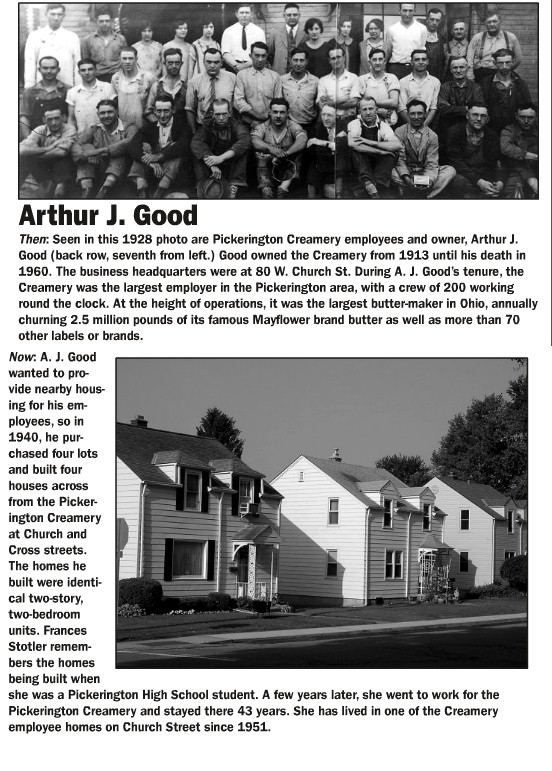- In 1900 a small group of local farmers organized and started a local creamery called Pickerington Elgin Butter Co. and continued as a co-op for about 10 years.
- Between 1910 and 1912, the co-op was brought by Creighton and Homer Pearce and renamed the Pearce Brothers Creamery.
- In 1913 Arthur J. Good came to Pickerington, Ohio as a butter maker for the creamery.
- Six months later Creighton Pearce retired from the business and sold his half of the business to Mr. Good.
- At that time the creamery became known as The Pearce and Good Creamery.
- In 1913 the plant churned 113,000 pounds of butter.
- A few years later Homer Pearce wanted to retire and so Mr. Good became the sole owner of the creamery.
- At that time the creamery became known as the Pickerington Creamery.
- In 1921 the creamery burned to the ground.
- Six months later in 1922 a new plant was built.
- By the mid 1920s the creamery bought the West Jefferson Creamery of Columbus, West Jefferson and Zanesville.
- During the late 1920s several more smaller companies were bought out by the Pickerington Creamery.
- With the coming of better roads and trucks, the old horse drawn equipment was replaced with a modern fleet of trucks.
- Three modern 1,200 pound churns were added and the Mayflower brand name was copyrighted.
- At that time the product line was expanded to include eggs, poultry, dried buttermilk, cheese, and non-fat dry milk.
- During 1935 an American cheese plant was put into operation in Bremen, Ohio. The cheese plant cost $15,000 to build.
- With the use of closed body trucks to pick up the milk and cream from the farmers, it was no longer feasible to pick up and handle poultry and this operation was eliminated in 1938.
- Then in April of 1942 a new milk drying plant was put into operation, near the creamery, in Pickerington. The milk drying plant handled 150,000 pounds of milk each day. This plant cost $50,000 to build.
- During 1949 the butter churns were replaced with new modern stainless steel churns.
- With the use of this new equipment the brand name was changed to Mayflower Gold-n-Flow.
- Pickerington Creamery was the first in Ohio and the third in the United States to install this continuous flow type of butter making equipment.
- In 1957 the creamery purchased the Warsaw Cheese Company, of Warsaw, Ohio. The creamery used this location as a milk receiving plant.
- Then in 1958 the Chief Dairy, of Upper Sandusky was purchased from the Isaly Milk Company. Isaly's had used the plant to produce butter and cheese. The Pickerington Creamery used this location for milk receiving and cheese production.
- In 1959 the Pet Milk plant at Fremont, Ohio was purchased to be used for a milk receiving plant. After a while this plant was closed and the milk was sent to the Chief plant in Upper Sandusky.
- By the early 1960s the Pickerington Creamery's producing and marketing area covered half of Ohio and parts of West Virginia, Kentucky, Indiana and Pennslyania.

- Arthur J. Good died in 1960. His namesake son took over until his death in 2008 (see AJ Good Jr.'s obituary here).
- The Pickerington plant was closed in November of 1972.
- At that time all Pickerington Creamery butter production was moved to the Upper Sandusky plant.
- By September of 1973 the Pickerington plant was sold to DMI (Dry Milk Institute) of Louisville, Kentucky. [AJ Good Jr. became a director of the American Dry Milk Institute.]
- The Upper Sandusky plant was closed, in 1978, bringing an end to the Pickerington Creamery Company.
- DMI continued to use the Pickerington plant to produce powder milk and whey until the plant was closed in 1989.
PICKERINGTON TIMES-SUN
_______________________________________________
Findlay Antique Bottle Club
Website - Facebook - Twitter - Google+ ~ TwitShot
Sign up for our free newsletter!











































I wish I could find out some info on a dry milk container that a received. Apparently it has been with one families members passed from one to another. It has been with the family for over 50 years. Wish I could find out how old it actually is. Either way I love it and it's in great condition. I want to paint it but don't know if it has any historical value before doing so.
ReplyDelete